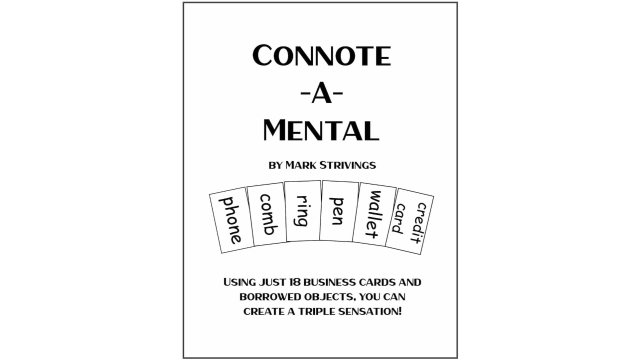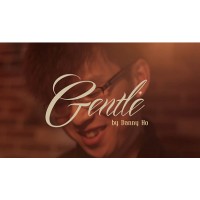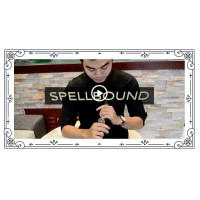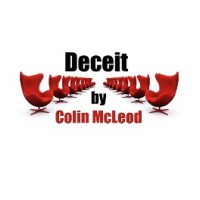Connote-A-Mental By Mark Strivings
- Product Code: T26367
- Reward Points: 20
- Availability: In Stock
- $20.00
-
$4.99
- Price in reward points: 499
We'll get to the details in a few moments, but first, allow me to lay out the groundwork.
There are a couple of terms that have been coined within the last 20 years or so with which I deeply identify - 'layers of deception' and 'depth of deception'. They are basically two different ways of describing the same thing.
What this means is that with any magic or mentalism effect, there is the effect itself and then there is the method. Sometimes between that method and the effect is basically a straight line. This can be good or bad. It's good in that it usually means that the effect in question is very clear. There's nothing in the handling or presentation to muddy the waters. Conversely, it can be bad in that should someone happen to stumble onto any aspect of that method, they've pretty much got how the effect works in its entirety.
'Depth of deception', or 'layers of deception' are those dodges and subterfuges that we use to put roadblocks between the method and the perception of the ultimate effect. This way, should spectator stumble upon a portion of the method for a given effect, it will only take them just so far in terms of sussing the whole thing out. What they think they know might explain one aspect of what they have witnessed, but it doesn't explain other parts of the mystery. In other words, they will run into a brick wall at some point.
One of the most common means of creating 'depth' to 'layers' is to utilize multiple methods in the course of an effect. Obviously this isn't always possible, and sometimes the end result actually muddies the overall picture to the detriment of the effect. Too much procedure. Too much 'other stuff' that can get in the way of the basic effect.
Another common means of creating 'depth' or 'layers' is the use of subtleties. These can take a huge number of different forms, and I am a massive fan of subtleties. In fact, it was the late, great Harry Lorayne (R.I.P, Harry) who said, and I will paraphrase, that the use of a subtlety is better than the use of a sleight, and he would take the former over the latter just about every time.
One of the things that I have always sought in terms of my own work was to add as much 'depth' to the deception as possible. I have several examples from my repertoire wherein multiple methods are in play. Likewise, I have pieces that have multiple subtleties involved. But from where I sit, the very best effects have both multiple methods and multiple subtleties. The deception is so 'deep' that it's virtually impossible to cut through.
Awhile back I came across a classic piece of mentalism which I had never heard of before. It turned out it's older than I am. Part of the reason that I wasn't familiar with it is because it was a marketed effect back in the day and is basically unavailable today. That will do it every time.
Anyway, when I read through the piece in question I was immediately struck by the clever use of multiple methods, along with the equally clever use of subtleties that are downright devious. Needless to say, I was immediately drawn to this piece. In point of fact, it almost instantly became a piece that I simply had to do. Just reading through it, I could instantly see how incredibly deceptive it is. The 'depth' or 'layers' of deception present in this piece are impressive, indeed, for a performance piece that is so direct and clean.
All of that being said, I was also immediately faced with a huge problem. One of the props used in this amazing piece, an every day item, was of a nature that its use today, as opposed to over 65 years ago when this was released, is pretty much taboo. As a direct result, if I was going to be able to do this amazing piece, I was going to have to fix this issue.
Among the multiple problems in fixing this issue is the fact that part of the actual method of the effect is directly tied to the use of this specific item, the item which I couldn't use. Finding a substitute proved to be a bigger issue than I initially thought it would be. Nonetheless, perseverance won out, and I was able to overcome the issue in question. So, YAY!
I could now do the effect.
But there was something more.
In the course of working with the effect, which was already using multiple methods and subtleties, it became apparent to me that there was even more that could be added in the methods and subtleties departments, that wouldn't weigh the effect down with unnecessary baggage. In other words, I had additional means, right at my fingertips, of adding even more deception to this already amazing effect, than was ever possible before. And I could do it without distracting from the effect or watering it down in any way.
Needless to say, the effect went from amazing to mind-numbing.
The real beauty of this effect is that it is criminally easy to do. In fact, the ratio of what the performer has to do to make this happen, as opposed to end result, is ridiculous.
So now, after taking no small amount of time to decide whether I wanted to send this out into the world or not, allow me to introduce you to...
by Mark Strivings
|
|
Reviews (0)
Recommend
Al Mann's Sensational Boiler Escape by Devin Knight & Al Mann
Al Mann's Sensational Boiler Escape by Devin Knight & Al Mann Download? A Psychic Demate..
$2.99 $5.50
Torn & Restored Transpo by David Williamson
Torn & Restored Transpo by David Williamson It's an effect in the working repertoire of many..
$1.99 $6.99
Comedy Magic For Preschoolers by David Ginn
Comedy Magic for Pre-Schoolers by David Ginn Do you want to entertain children under age six? He..
$3.99 $6.99
Confetti Card by Darryl Davis & Daryl Williams
Confetti Card by Darryl Davis & DaryI Williams (a.k.a. The Other Brothers) Thi..
$2.99 $5.99
Gentle by Danny Ho
Gentle by Danny Ho (VE MA) Gentle?is an extreme coin magic tutorial by Danny Ho.? You are going..
$2.99 $5.99
Peanut Butter And Jelly Pro Presented by Dan Harlan
Peanut Butter and Jelly PRO presented by Dan Harlan? ALL NEW PRO PRESENTATION. The family-sho..
$2.99 $5.99
Kill Bill by Dan Harlan
Kill Bill by Ari Bhojez presented by Dan Harlan A torn and restored card using a signed borrowe..
$2.99 $5.39
Cut And Restored Rope
Cut and Restored Rope This is THE Cut and Restored Rope routine to do. It's fun, visual, an..
$1.99 $4.50
Spellbound Magic by Creative Artists And Yuxu
Spellbound Magic download (video) by Creative Artists and Yuxu ($10.00) At Vanishing Inc. Magic we..
$1.99 $4.59
Tu by Creative Artists And Nguyen Ngoc Tu
Tu by Creative Artists and Nguyen Ngoc TuThe 'Creative Artists' are a wildly talented group of magic..
$2.99 $5.99
Promystic Colormatch by Colin Mcleod And Blake Adams
ProMystic ColorMatch by Colin Mcleod and Blake Adams PDF Description ColorMatch is a ..
$15.99 $31.99
Deceit Chair Prediction by Colin Mcleod
Colin Mcleod - Deceit - Chair PredictionPDFMany people who have now read the book have offered many ..
$4.99 $8.98
Blazzard by Cigma Magic
Fire has long been used as a catalyst to trigger subsequent magic effects. However, heating up objec..
$2.99 $5.39
Half Track by Christopher Taylor
Half Track by Christopher Taylor A miracle-class Think-a-Card routine with two participants present..
$4.99 $8.00
Cigatration by Chris Westfall
Cigatration by Chris Westfall Ever thought about doing ""Cigarette Through Coin""? This is THE ..
$1.99 $4.99


















